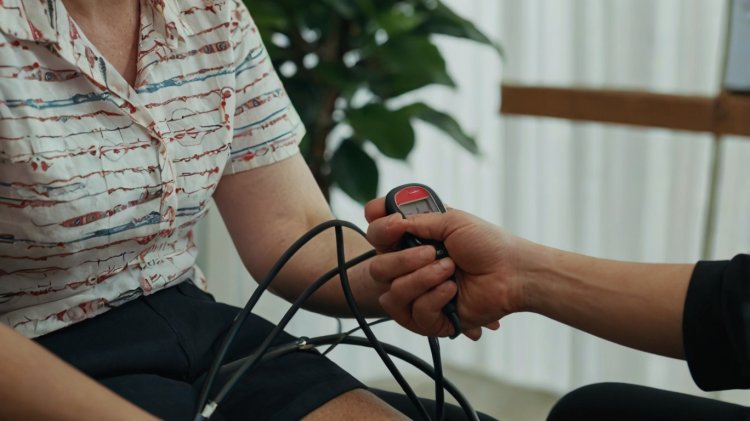How Arm Position Affects Blood Pressure Accuracy: Key Insights
Learn how arm positioning during blood pressure measurements can impact accuracy. Discover proper techniques to avoid misdiagnosis and manage hypertension effectively.

Accurate Blood Pressure Readings: How Arm Position Matters
Introduction
Blood pressure measurements are a cornerstone of cardiovascular health management. However, the accuracy of these readings can be significantly influenced by seemingly minor factors, such as the position of your arm during the measurement. Recent research reveals that different arm positions can alter blood pressure readings, potentially leading to misdiagnosis or unnecessary treatments.
This article delves into the science behind blood pressure readings, the impact of arm positioning, and how you can ensure accurate measurements at home and in clinical settings.
Understanding Blood Pressure Readings
Blood pressure readings consist of two numbers:
-
Systolic Pressure: The pressure exerted on artery walls during heartbeats.
-
Diastolic Pressure: The pressure when the heart rests between beats.
Blood Pressure Categories
| Category | Systolic (mm Hg) | Diastolic (mm Hg) |
|---|---|---|
| Normal | <120 | <80 |
| Elevated | 120-129 | <80 |
| High (Stage 1) | 130-139 | 80-89 |
| High (Stage 2) | ≥140 | ≥90 |
| Hypertensive Crisis | >180 | >120 |
Accurate readings are crucial for appropriate diagnosis and treatment. Even small deviations can result in significant differences in categorization and management.
How Arm Position Affects Blood Pressure Readings
A recent study published in JAMA Internal Medicine highlights how different arm positions can lead to variations in blood pressure readings. The study involved 133 adults and examined blood pressure measurements across three arm positions:
-
Arm Supported on a Hard Surface (e.g., Desk)
-
Produced the most accurate readings.
-
Systolic and diastolic readings were lower compared to other positions.
-
-
Arm Resting on the Lap
-
Resulted in a systolic increase of 3.9 mm Hg and diastolic increase of 4 mm Hg.
-
-
Arm Dangling by the Side
-
Showed the highest readings, with systolic up by 6.5 mm Hg and diastolic by 4.4 mm Hg.
-
These variations, while seemingly minor, could change a person’s hypertension categorization and lead to unnecessary interventions.
Guidelines for Accurate Blood Pressure Measurement
The American Heart Association (AHA) Recommendations
To ensure accurate blood pressure readings, follow these guidelines:
-
Preparation:
-
Avoid caffeine, smoking, and exercise 30 minutes before the measurement.
-
Sit calmly for at least 5 minutes prior.
-
-
Positioning:
-
Sit with your back supported and feet flat on the floor.
-
Rest your arm on a hard surface at heart level.
-
-
Measurement:
-
Use an appropriately sized cuff placed on the upper arm.
-
Take multiple readings at the same time each day for consistency.
-
Implications of Inaccurate Readings
Potential Misdiagnosis
A misreading due to improper arm positioning could:
-
Push systolic readings above 130 mm Hg, leading to a hypertension diagnosis.
-
Result in unnecessary medication prescriptions.
Health Risks
Misdiagnosis not only leads to overtreatment but also increases stress and healthcare costs. Conversely, underestimating blood pressure can delay necessary interventions, heightening the risk of cardiovascular events.
Tips for Patients
At-Home Blood Pressure Monitoring
To ensure accuracy when monitoring blood pressure at home:
-
Set Up Correctly:
-
Use a validated home blood pressure monitor.
-
Position your arm on a sturdy surface at heart level.
-
-
Follow Protocols:
-
Measure at the same time daily.
-
Avoid distractions and remain still during the reading.
-
-
Track Results:
-
Keep a log of your readings to share with your healthcare provider.
-
Be Your Own Advocate
-
Ask for a repeat reading if the initial measurement seems inconsistent.
-
Discuss proper measurement techniques with your healthcare provider.
High Blood Pressure: Facts and Prevention
Key Statistics
-
Nearly half of U.S. adults have high blood pressure.
-
High blood pressure contributed to over 685,000 deaths in the U.S. in 2022.
Symptoms of Hypertension
-
High blood pressure often presents no symptoms but may include:
-
Dizziness
-
Flushed skin
-
Visual disturbances
-
Prevention Strategies
-
Eat a balanced diet rich in fruits and vegetables.
-
Maintain a healthy weight.
-
Exercise regularly (150 minutes of moderate activity per week).
-
Limit alcohol and avoid smoking.
-
Manage stress effectively.
Frequently Asked Questions
Q1. Why does arm position matter in blood pressure readings? Arm position affects the pressure exerted on arteries, leading to variations in readings. Proper positioning ensures accurate measurements.
Q2. How can I measure blood pressure correctly at home? Sit with your back supported, feet flat on the floor, and arm resting on a hard surface at heart level. Follow the device’s instructions for best results.
Q3. Can inaccurate readings lead to misdiagnosis? Yes, improper techniques can result in readings that misclassify your blood pressure, potentially leading to unnecessary treatments or missed diagnoses.
Q4. What is the ideal arm position during a blood pressure check? The arm should be supported on a hard surface at heart level for the most accurate readings.
Q5. What lifestyle changes help prevent high blood pressure? Maintain a healthy diet, exercise regularly, avoid smoking and excessive alcohol, and manage stress to keep blood pressure in check.
Conclusion
Accurate blood pressure readings are vital for diagnosing and managing hypertension. Factors such as arm positioning can significantly influence results, potentially leading to misdiagnosis or inappropriate treatments. By understanding and following proper measurement techniques, both patients and healthcare providers can ensure better health outcomes and reduce cardiovascular risks.










